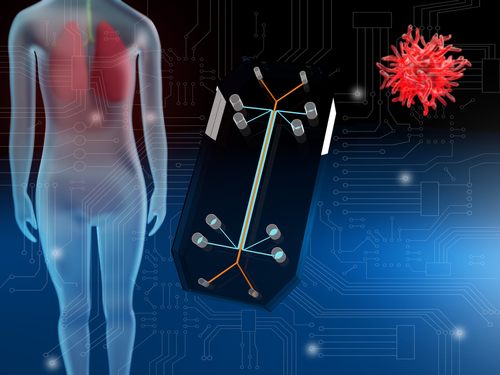Lung-on-a-chip technology: Streamlining drug-testing for pulmonary fibrosis
ANI May 28, 2018
Researchers from the University of Buffalo have worked to develop a biotechnology that could streamline the drug-testing process for medicines to treat pulmonary fibrosis, one of the most common and serious forms of lung disease.

The one reason for developing a treatment for pulmonary fibrosis is that it's difficult to mimic how the disease damages and scars lung tissue over time, often forcing scientists to employ a hodgepodge of time-consuming and costly techniques to assess the effectiveness of potential treatments. The innovation relies on the same technology used to print electronic chips, photolithography. Only instead of semiconducting materials, researchers placed upon the chip arrays of thin, pliable lab-grown lung tissues - in other words, its lung-on-a-chip technology.
"Obviously it's not an entire lung, but the technology can mimic the damaging effects of lung fibrosis. Ultimately, it could change how we test new drugs, making the process quicker and less expensive," said lead author Ruogang Zhao. With limited tools for fibrosis study, scientists have struggled to develop medicine to treat the disease. To date, there are only two drugs - pirfenidone and nintedanib - approved by the U.S. Food and Drug Administration that help slow its progress.
However, both drugs treat only one type of lung fibrosis: idiopathic pulmonary fibrosis. There are more than 200 types of lung fibrosis, according to the American Lung Association, and fibrosis also can affect other vital organs, such as the heart, liver, and kidney. Furthermore, the existing tools did not simulate the progression of lung fibrosis over time - a drawback that has made the development of medicine challenging and relatively expensive. Zhao's research team created the lung-on-a-chip technology to help address these issues.
Using microlithography, the researchers printed tiny, flexible pillars made of a silicon-based organic polymer. They then placed the tissue, which acts like alveoli (the tiny air sacs in the lungs that allow us to consume oxygen), on top of the pillars. Researchers induced fibrosis by introducing a protein that causes healthy lung cells to become diseased, leading to the contraction and stiffening of the engineered lung tissue. This mimics the scarring of the lung alveolar tissue in people who suffer from the disease.
The tissue contraction caused the flexible pillars to bend, allowing researchers to calculate the tissue contraction force based on simple mechanical principles. Researchers tested the system's effectiveness with pirfenidone and nintedanib. While each drug works differently, the system showed the positive results for both, suggesting the lung-on-a-chip technology could be used to test a variety of potential treatments for lung fibrosis. The study appears in the journal Nature Communications.
-
Exclusive Write-ups & Webinars by KOLs
-
Daily Quiz by specialty
-
Paid Market Research Surveys
-
Case discussions, News & Journals' summaries